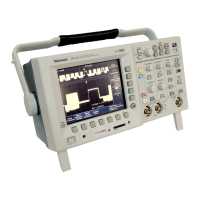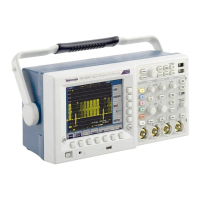Appendix A: Specifications
Inputs
Input coupling
DC, AC, or GND
Channel input remains terminated when using G ND coupling.
Input
impedance,
DC coupled
1MΩ ±1% in parallel with 13 pF ±2 pF, TekProbe compatible
50 Ω ±1%
VSWR ≤ 1.5:1 f
rom DC to 500 MHz, V/div settings ≥ 100 mV, typical
VSWR ≤ 1.6:1 from DC to 500 MHz, V/div settings < 100 mV, typical
Overvoltage category
Maximum vol
tage
Non-Mains
Environment
150 V
RMS
(400 V
pk
, Duty Factor of
37.5%)
CAT II Environment
1
100 V
RMS
(400 V
pk
, Duty Factor of
25%)
Maximum
voltage at input
BNC (1 MΩ)
For stea
dy-state sinusoidal waveforms, derate at 20 dB /decade above
200 kHz to 13 V
pk
at 3 MHz and above.
Maximum
voltage at input
BNC (50 Ω)
5V
RMS
wi
th peaks ≤ ±30 V
Maximum
transient
overvo
ltage
400 V
pk
Maximum
floati
ng voltage
0Vfro
m chassis (BNC) ground to earth ground, or
30 V
RMS
(42 V
pk
) only under these conditions: no signal voltages >30 V
RMS
(>42 V
pk
), all common l eads connected to the same voltage, no grounded
perip
herals attached
Measured on one channel, with test signal applied to another channel, and
with
the same scale and coupling settings on each channel
Frequency range
Cro
sstalk
≤ 100 MHz ≥ 100:1
≤ 300 MHz ≥ 50:1
Chan
nel
to channel
crosstalk,
typ
ical
≤ 5
00 MHz
≥ 3
0:1
Di
fferential
delay, typical
100 ps between any two channels with the same scale and coupling
se
ttings
1
For definitions, refer to Compliance Information. (See page viii, Compliance information.)
122 TDS3000C Series Oscilloscope User Manual
